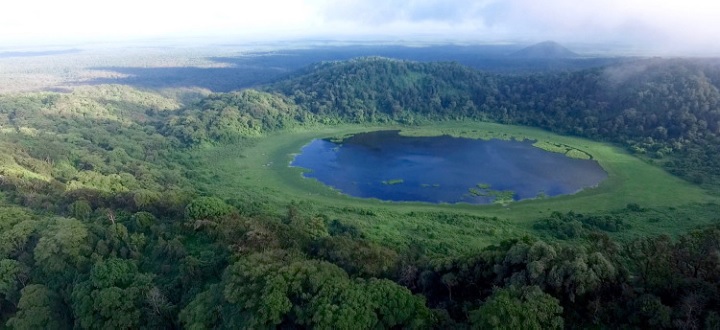Cloud forests are tropical montane – or mountain forests – which, as the name suggests, are covered in clouds or fog most of the time. The trees are short with twisted stems, and their branches are covered in mosses, creating a beautiful fairy tale-like atmosphere.
The forests are incredibly rich in biodiversity, hosting well-known species like the mountain gorilla. They also have many endemic species such as chameleons which are unique to particular forests.
Also known as Water Towers, one of their unique features is an ability to trap water from clouds – the branches, leaves and mosses collect droplets which drip down to the ground and run into groundwater aquifers. In drier areas – such as Africa where little research has been carried out – cloud water is often the main source of water available to plants.
Benefits
Apart from water, cloud forests provide numerous benefits to human beings: timber, firewood, building materials, medicinal plants, wild fruits and honey. Several highly valued tropical timber trees are harvested from these forests. Cloud forests also play an important role in climate modulation, carbon sequestration and preventing landslides. They are culturally important with many ethnic groups acting as their ‘shepherds’.
But despite their benefits, cloud forests are among the most threatened ecosystems on Earth due to the combined effects of population growth, land use change and climate change.
Timber extraction; clearing land for mining, agriculture or grazing; illegal poaching and unsustainable harvesting of medicinal plants are all activities which threaten these ecosystems.
Slow growers
Problems for the cloud forests are compounded by the fact that the trees grow slowly because of the low temperatures and nutrient-poor soils. These forests take a long time to recover after disturbance.
Climate change is another concern. With increased temperatures, the cloud base rises and clouds are formed at higher altitudes. Some areas of cloud forest no longer have clouds and become drier. As a result, trees die or cannot regenerate.
What can be done to save them? Finding the balance between forest conservation and sustainable use is particularly challenging, and lack of accurate data and insight into these ecosystems hampers management interventions.
The forgotten African forests
Cloud forests in Africa are the least studied, and the most threatened by predicted changes in climate. Our research is focused on three remote cloud forests in northern Kenya: Mount Nyiro, Mount Kulal and Mount Marsabit.
As part of the rescue effort for the African forests, our research is studying the interaction between the forest and the local climate - and between the forest and the people who use them. The project combines research methods from natural and social sciences. Local communities, managers and other stakeholders are actively involved in the work.
Local people work with the researchers to collect climate data, share their views on preliminary findings, and suggest potential management interventions such as limited harvesting of certain species. This partnership approach ensures a greater understanding of the way the cloud forest functions, and also helps to identify conservation strategies which do not exclude local communities.
Cloud forests on film
We are also actively involved in science outreach. Thanks to a grant from the Scientific Exploration Society, we produced a short film about the threatened cloud forests of northern Kenya. I was part of a team who spent a month in northern Kenya filming in the forests and interviewing local people and forest managers. We drove over 1000km – mostly across desert – climbed mountains and slept in tents and herders huts where we drank lots of tea with local villagers.
The film will be screened at several environmental film festivals
The Cloud Shepherds from Xavier de Diego on Vimeo.
Meanwhile, our research continues. A new project funded by a Global Marie Curie Fellowship called African Sky Forests will study the cloud forests of the Albertine Rift in DR Congo, and those in Cameroon, to gather more of the key information needed to help preserve these incredible ecosystems.
The text of this article is licensed under a Creative Commons Licence. You're free to republish it, as long as you link back to this page and credit us.





